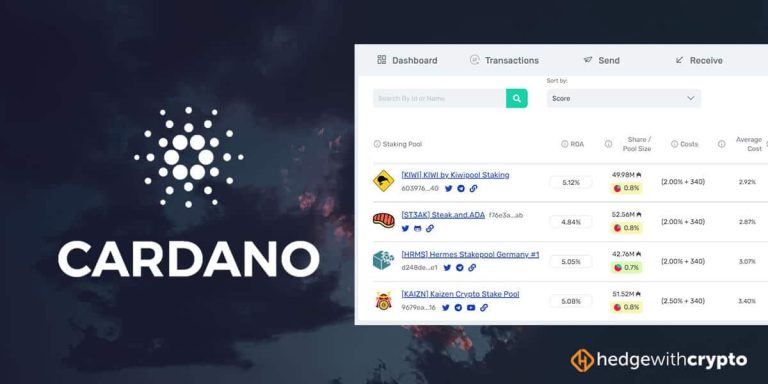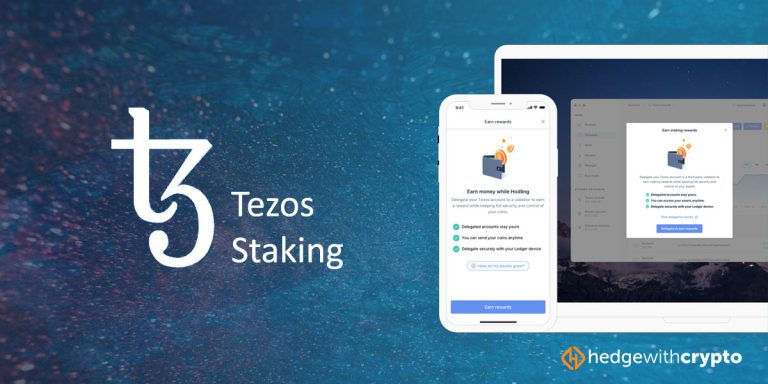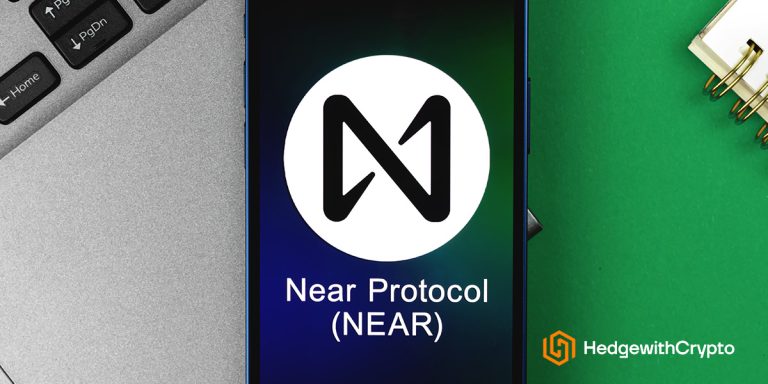Where To Stake Polkadot
The information provided on this page is for educational purposes only and is not intended as investment advice. We may receive compensation from our partners if you visit their website. Read our disclaimer to learn how we make money.
TABLE OF CONTENTS
Polkadot (DOT) is one of the most popular coins to stake and earn income based on the amount delegated to the network by investors. Polkadot can be staked using an on-chain wallet or supported cryptocurrency staking platforms. In this article, we explain how to stake Polkadot and the best places to stake DOT tokens or rewards.
These are the best wallets and exchanges for staking Polkadot to earn passive DOT rewards based on our reviews and comparisons:
- Binance (best overall platform for staking Polkadot)
- Kraken (best Polkadot staking option for non-USA residents)
- ByBit (best way to stake DOT for active traders)
- Ledger wallet (best Polkadot staking wallet for security)
- Crypto.com (best mobile app with flexible Polkadot staking)
- KuCoin (best exchange for beginners to stake Polkadot)
- CEX.IO (best for staking Polkadot with no lock-in terms)
- Bitfinex (best DOT staking exchange with no minimums)
Best Places To Stake Polkadot: Reviewed & Compared
| PLATFORM | NUMBER OF COINS | STAKING FEE | RATING | PROMOTION | WEBSITE | REVIEW |
|---|---|---|---|---|---|---|
|
|
None |
None |
Rating
We provide an overall weighted average rating out of 5 stars. Our ratings are based on objective criteria like the ease of use, fees, deposit methods, customer support and availability. Our reviews are not influenced by 3rd parties. Click here for further information about our rating methodology and a full list of categories we review against. 4.8 / 5 |
Up to $100 welcome bonus |
Visit Binance | Binance Review |
 ByBit ByBit
|
None |
None |
Rating
We provide an overall weighted average rating out of 5 stars. Our ratings are based on objective criteria like the ease of use, fees, deposit methods, customer support and availability. Our reviews are not influenced by 3rd parties. Click here for further information about our rating methodology and a full list of categories we review against. 4.8 / 5 |
0% trading fees for 30 days (spot only) |
Visit ByBit | ByBit Review |
|
|
None |
15% |
Rating
We provide an overall weighted average rating out of 5 stars. Our ratings are based on objective criteria like the ease of use, fees, deposit methods, customer support and availability. Our reviews are not influenced by 3rd parties. Click here for further information about our rating methodology and a full list of categories we review against. 4.8 / 5 |
None available at this time |
Visit Kraken | Kraken Review |
 Ledger Wallet Ledger Wallet
|
None |
None |
Rating
We provide an overall weighted average rating out of 5 stars. Our ratings are based on objective criteria like the ease of use, fees, deposit methods, customer support and availability. Our reviews are not influenced by 3rd parties. Click here for further information about our rating methodology and a full list of categories we review against. 4.7 / 5 |
None available at this time |
Visit Ledger Wal… | |
|
|
None |
15% |
Rating
We provide an overall weighted average rating out of 5 stars. Our ratings are based on objective criteria like the ease of use, fees, deposit methods, customer support and availability. Our reviews are not influenced by 3rd parties. Click here for further information about our rating methodology and a full list of categories we review against. 4.6 / 5 |
Up to 500 USDT in bonuses |
Visit KuCoin | KuCoin Review |
|
|
None |
None |
Rating
We provide an overall weighted average rating out of 5 stars. Our ratings are based on objective criteria like the ease of use, fees, deposit methods, customer support and availability. Our reviews are not influenced by 3rd parties. Click here for further information about our rating methodology and a full list of categories we review against. 4.2 / 5 |
None available at this time |
Visit Crypto.com | Crypto.com Revie… |
|
|
None |
None |
Rating
We provide an overall weighted average rating out of 5 stars. Our ratings are based on objective criteria like the ease of use, fees, deposit methods, customer support and availability. Our reviews are not influenced by 3rd parties. Click here for further information about our rating methodology and a full list of categories we review against. 4.2 / 5 |
None available at this time |
Visit CEX.IO | CEX.IO Review |
 Bitfinex Bitfinex
|
None |
None |
Rating
We provide an overall weighted average rating out of 5 stars. Our ratings are based on objective criteria like the ease of use, fees, deposit methods, customer support and availability. Our reviews are not influenced by 3rd parties. Click here for further information about our rating methodology and a full list of categories we review against. 3.8 / 5 |
None available at this time |
Visit Bitfinex | Bitfinex Review |
1. Binance
Binance launched the staking of Polkadot via its Binance Earn facility on October 21st, 2020. It is the world's leading cryptocurrency exchange that allows DOT stakers to earn as high as 36.79% APY. Polkadot is one of the leading staked cryptocurrencies on Binance that enables investors to lock up their DOT for 15, 30, and 120 days.
Short-term investors looking to make significant gains through staking can lock their DOT for 15 days and earn the highest APY of 36.98%. Staking DOT for 30 days offers 11.51% APY, and if users choose the maximum 120-days lock-in period, they can earn 20.98% APY. Investors need to lock at least 10 DOT to start earning rewards. There are two types of locked staking provided: Single Locked staking and Total Locked staking. Investors choosing single locked staking can stake a maximum of 10000 DOT. For Total Locked Stakers, the limit is 3 million DOT.
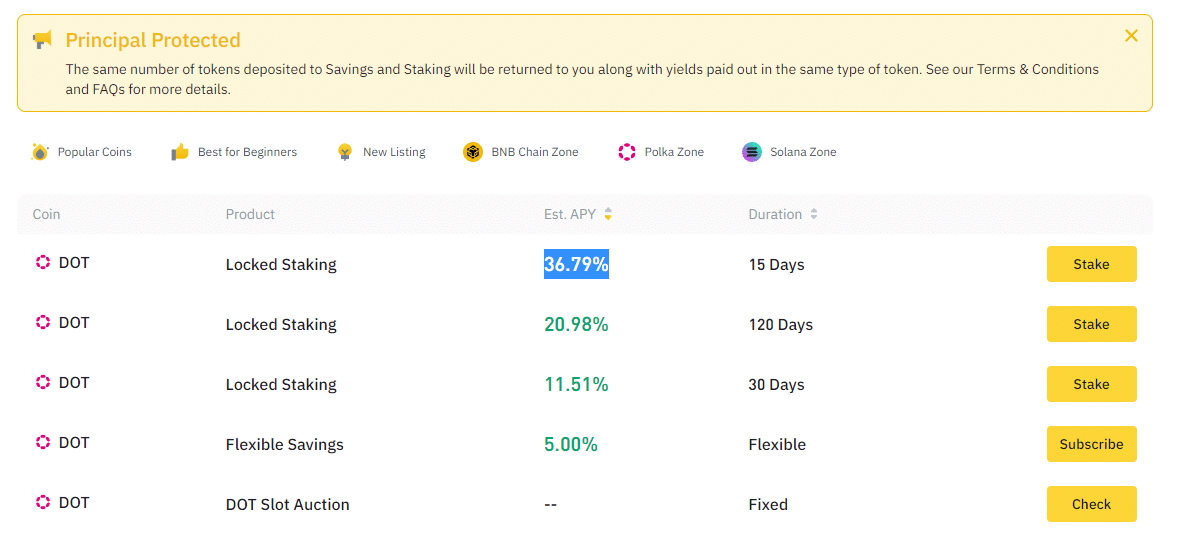
The above-average DOT staking rewards that Binance provides make it the overall best platform to stake Polkadot. The inclusion of flexible savings for Polkadot on Binance is suitable for beginners who want to earn passive income on DOT tokens without committing and locking their assets. There are also zero fees for staking. However, staking DOT is not available for US users, and the platform is not beginner-friendly. It is therefore recommended only to choose Binance if the investors have the know-how of the Binance platform.
Another thing to note is that Binance has changed its terms of staking Polkadot. The original staking periods used to be 30, 60, and 90 days with APYs being 18.34%, 22.49%, and 31.49%, respectively. These staking rates and locking periods have since changed. While it is a positive change since it can help investors earn higher rewards, the APY can decrease in the future if the platform deems it necessary. Along with locked staking, Binance also provides investors income to Polkadot holders by providing them with a flexible savings facility. That allows users to earn 5.00% APY. For more information, read our article on where to earn interest on crypto assets.
2. Kraken
Kraken is one of the world's leading trading exchanges known for providing a simple-to-use interface to trade or stake cryptocurrencies. Known for its accessibility, safety, and competitive pricing among seasoned crypto investors, Kraken is one of the best exchanges in the market for investors who want to do more than just trade crypto. Investors can use Kraken to stake Polkadot and other 11 assets and hold them in the official Kraken Wallet.
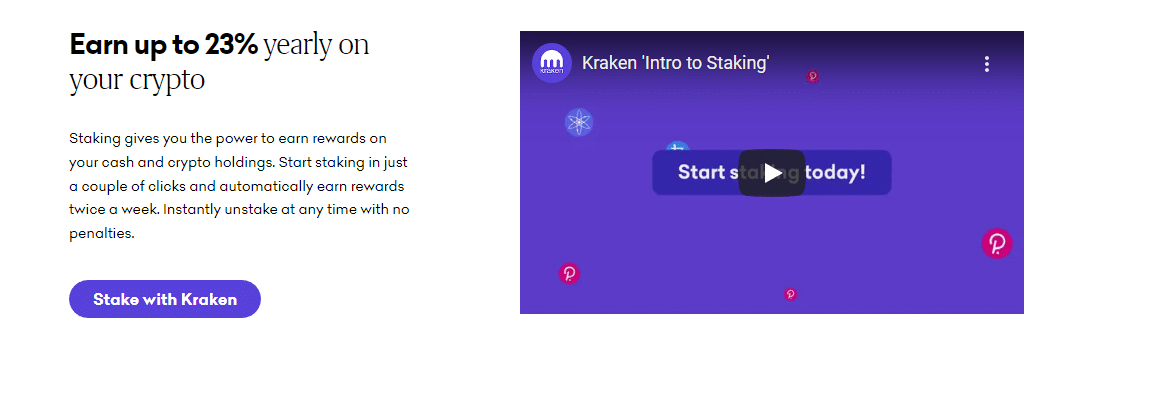
Kraken introduced On-chain staking for Polkadot along with Cosmos on August 18th, 2020. Investors can earn up to 12% APY by staking their Polkadot tokens. Investors earn daily payouts on their staked Polkadot twice every week. Also, if the investors want to exit their staking position, they can do so by transferring their DOT tokens from the staking Wallet to the spot wallet.
While Kraken provides lower staking rewards than Binance, it follows a flexible and simple DOT staking procedure. Investors don't need to lock in DOT tokens for a certain period of time to withdraw the rewards. With Kraken, they can exit their stake position anytime that they want. However, Kraken charges a 15% commission on all staking assets which should be considered.
Overall, Kraken is relatively simple to use with a straightforward user interface for various investors to begin staking Polkadot. However, the drawback is that Kraken's staking service has been shut down in the USA.
3. ByBit
ByBit is an exceptional trading platform for crypto margin and is regularly featured amount the top 5 exchanges in the world for its trading volume and liquidity on its derivatives market. The added benefit for traders on ByBit is they can also earn staking rewards on several tokens including Polkadot. The estimated reward for staking DOT on ByBit is 1.77% APY, which is much lower than its competitors. However, the benefit is that traders can earn Polkadot staking rewards while actively trading on a world-class crypto margin trading platform.
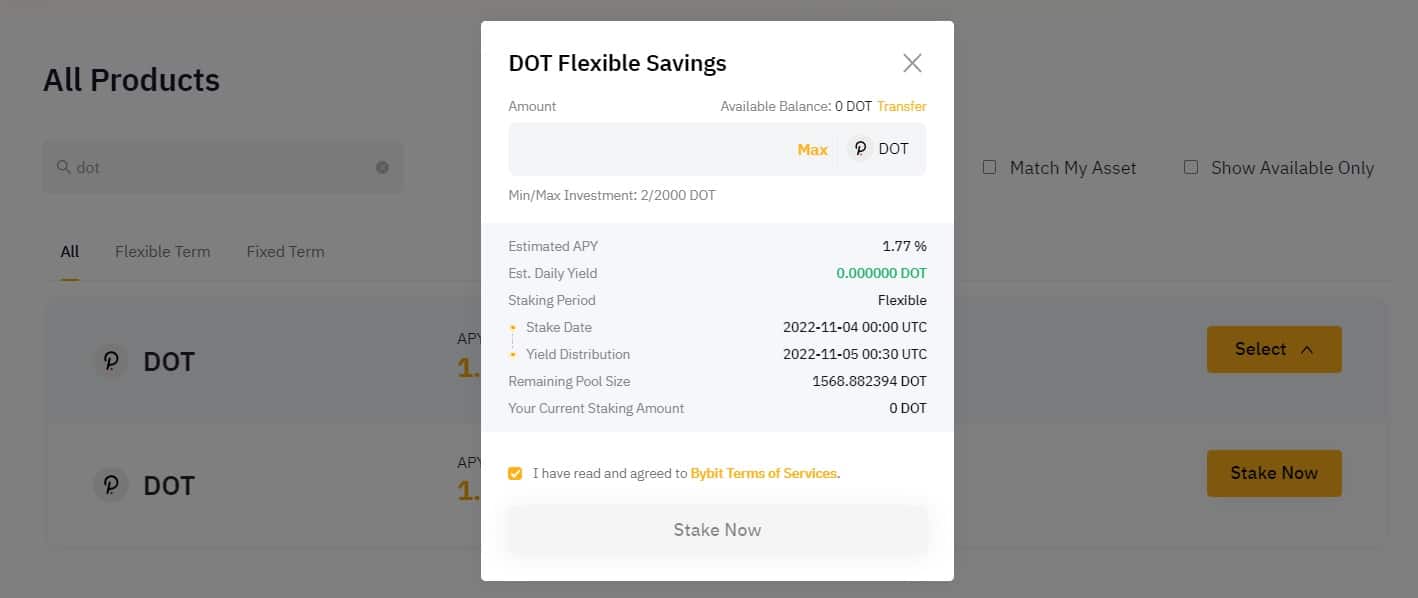
The lower staking reward for DOT is attributed to the fact there are no locked staking products on ByBit. The only available option is flexible staking, which can be advantageous for frequent traders to earn a small staking reward on idle DOT funds while in between trades. Moreover, the DOT tokens can be withdrawn at any time and transferred to the trading wallet.
ByBit has a lower entry barrier to stake Polkadot with a minimum of 2 DOT only. However, there is a maximum cap in place which is restricted to 2,000 DOT tokens which may not be ideal for large net-worth traders.
4. Ledger Nano Wallet
Ledger is a hardware crypto wallet and one of the best physical assets to hold and stake Polkadot. It holds the DOT tokens offline and provides an additional layer of security to the users’ crypto assets. Users can earn an average of 14% APY for staking Polkadot.
To start staking Polkadot on a Ledger Nano device, investors must participate in the Polkadot network as a nominator. Afterward, the nominator must choose the validators. The Ledger device recommends that the users make a careful selection since the APY rewards depend upon how well the validators behave. In case the validators don't act by the Polkadot protocol, the rewards can be slashed. In extreme cases, the protocol can penalize the nominator and take a portion of their DOT holdings.
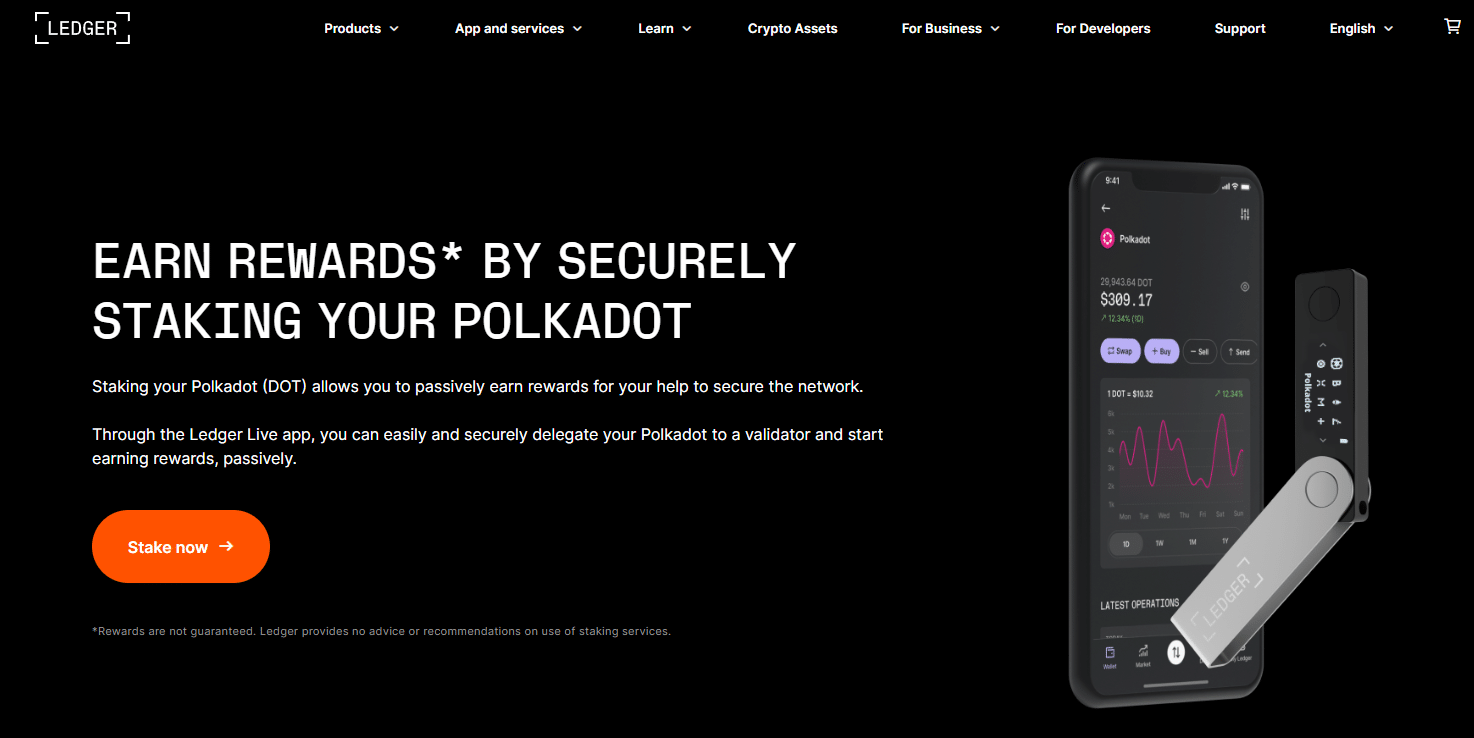
Investors must stake around 80 DOT tokens to start staking DOT. The protocol will then begin the election process, and if the user is selected as a nominator, they'll begin to receive great rewards. The locking period is 28 days. Users must use Ledger Live – a desktop software – to manually claim their DOT staking rewards. Therefore, this method of staking is also only fit for seasoned investors who are enthusiastic about the ecosystem and can carry out their validator selection properly.
While there are no staking commissions involved, a Ledger device is not the most frugal option. There is the upfront cost to purchase a hardware wallet which can be high for beginners who've just started to learn about staking and want to give it a try. Compared to Binance, which provides a free desktop interface, a hardware wallet is an option suitable for only those who are willing to put significant investment into buying a ledger wallet and want the best security of their Polkadot investment.
5. Crypto.com
Crypto.com is a leading cryptocurrency exchange known for a wide array of services, including spot trading, a VISA crypto card, an NFT marketplace, and Crypto Earn: a facility that allows investors to stake their crypto assets to earn passive income. It is a mobile-first platform, offering beginners and seasoned investors the to conduct trading or earn rewards on various crypto coins such as staking Ethereum and even staking Solana. Crypto.com offers 3 ways to stake Polkadot as follows:
- Flexible Staking: It allows users to earn 1.15% to 1.45% APY for staking Polkadot.
- 1-month Staking: It allows users to earn 1.3% to 12% APY for staking Polkadot.
- 3-month staking: It allows users to earn from 1.78% to 14.5% APY for staking Polkadot
The wide difference between the rewards exists because of Crypto.com's requirement to stake the native CRO tokens. The higher the number of CRO tokens staked, the APY an investor earns. To earn the highest APY listed, users must stake CRO tokens worth $40,000.
Related: How to stake Cronos (CRO).
Technically, Crypto.com provides one of the highest APY in this list. However, the requirement to stake a massive amount of CRO can offset the profits earned. Additionally, it can be difficult for investors to learn about the rewards because the on-site explanation is confusing. That being said, Crypto.com is one of the best mobile apps for crypto and is a good fit for investors on the go that want to stake Polkadot without any issues. Moreover, there are zero platform commissions for staking and the minimum to get started is 1 DOT.
6. Kucoin
Kucoin Is a Hong-Kong based cryptocurrency exchange known for a diverse collection of crypto trading pairs. With a trading volume exceeding $6.5 billion and support for more than 600 crypto assets, Kucoin is also one of the preferred platforms for staking. Users can earn up to 7.31% APY for their DOT tokens. It is a flexible staking option. That is, investors don’t need to wait for the lock-up period to be over to withdraw their rewards.

To stake Polkadot on Kucoin, investors must use Pool-X which is their trading platform. There is a minimum staking requirement of 0.2 DOT. Another way that investors can stake their Polkadot tokens is through the Parachain Slot Auction. This way, crypto enthusiasts can stake their tokens in the Polkadot project they support. However, unlike standard staking, users receive on-chain rewards only after the lease period is over.
Simply put, investors stake their tokens in a project. If the project wins the slot bid, staked rewards are generated. Kucoin then transfers the rewards to Pool-X. The tokens are returned to the user's account if the project fails to win the slot bid. The downside of staking DOT on KuCoin is the 15% commission fee.
7. CEX.IO
CEX.IO is a cryptocurrency exchange in the UK that provides facilities that allow investors to convert fiat money into digital currencies. That platform is fit for beginners and seasoned investors since it offers multiple views based on the level of the investor's expertise. The trading tools provided by CEX.IO are robust and allow users to analyze the crypto market before investing.
The staking platform allows users to earn passive interest on crypto assets they hold, including DOT, ADA, and more. Investors only need to either buy DOT tokens or transfer them to the CEX portfolio to start earning rewards through staking. There are no commissions or fees to eat into the rewards and users can begin staking Polkadot with 1 DOT.

CEX.IO offers 10% APY for staking Polkadot which investors can withdraw whenever they want. As there are no lock-in terms, investors will always have access to their tokens to react to the rapidly changing crypto market to make bigger gains. CEXO calculates staking benefits daily and transfers them to the user's account monthly. Compared to Binance, that's a disadvantage as Binance provides daily rewards that investors can transfer to their wallets at any time.
In short, CEX.IO is a reputable place to earn staking rewards on DOT with a total of $42.2 million worth of staking assets according to the website. It has paid up to $465,000 in rewards.
8. Bitfinex
Bitfinex is one of the most technically-intensive trading platforms that is favored among seasoned crypto investors. It has high traffic, trading volume, and liquidity and has earned renown as a liquidity provider to other crypto platforms. It has top-shelf features that set it apart from the rest, including an advanced trading platform, an OTC market, margin trading, a peer-to-peer financing utility, and trading. Investors can earn up to 7% APY by staking Polkadot. The staking process is simple as all an investor needs to do is to hold the DOT tokens in a Polkadot wallet.
The platform is sophisticated by layman standards but simple from a seasoned investor's standpoint. Bitfinex doesn’t have any minimum requirements for staking. That is, even if the investors stake 1 DOT, they can earn 0.07 DOT by the year’s end. That being said, Bitfinex has drawn some criticism for not being transparent enough. Bitfinex takes a portion of staking benefits when the investor withdraws the rewards, but the platform hasn’t specified the amount.
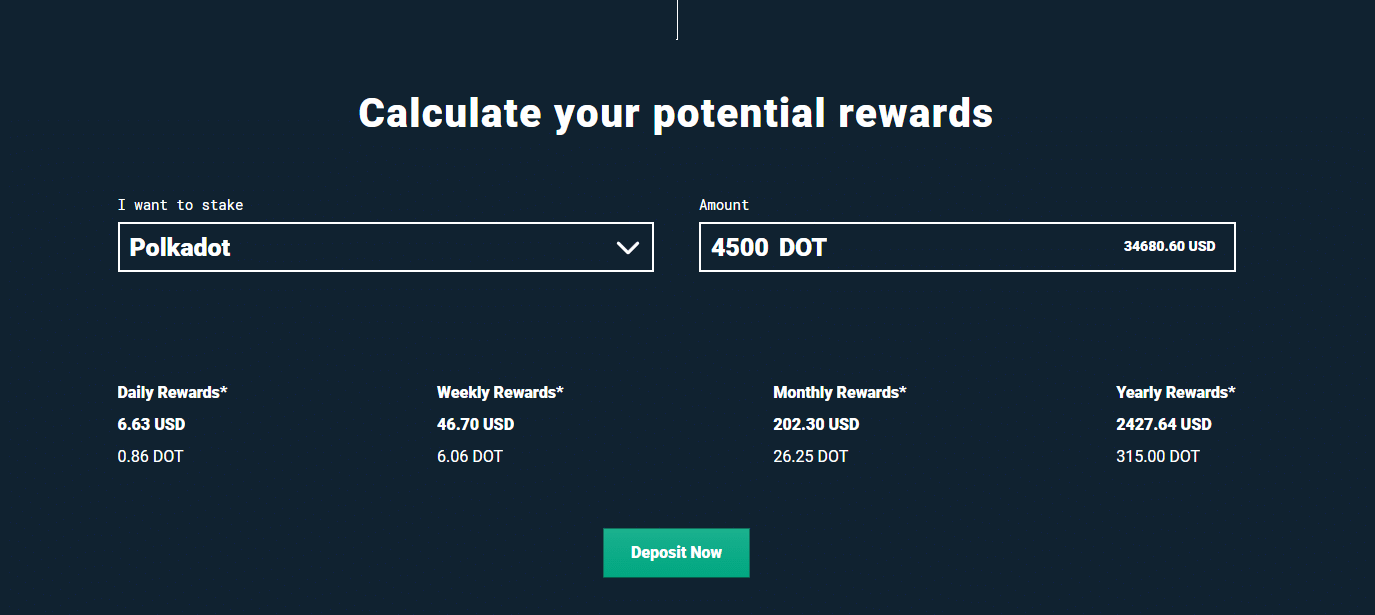
On the other hand, Bitfinex pays weekly rewards and transfers them directly to the users' wallets. While the funds can be used at any time on the platform, the rewards cannot be used for trading or can be withdrawn. Bitfinex takes a snapshot of the number of DOT tokens in the middle of the week and distributes the rewards accordingly.
Compared to Binance and Kraken, the rewards for DOT are quite low. Moreover, the lack of transparency in rewarding the fee is also a concern. While Bitfinex has stated that it “takes a portion of staked rewards” to facilitate withdrawals, there is no straight answer. That being said, the accessible UI and simple staking procedure are right for seasoned crypto investors who want to earn DOT staking rewards every week.
What Is Polkadot (DOT)?
Polkadot is a cryptocurrency project that was founded in 2016 and aims to provide a decentralized Internet or web application for blockchain networks to communicate with each other. The network is a multichain protocol design that allows information and transactions to be performed in a secure and trustless environment. An open-source, sharded multichain protocol, Polkadot is the foundation for a decentralized internet for the blockchain.
The native currency of the blockchain platform is the DOT token that is used for security and governance, staking to validate operations and connect to several different chains into a single network to allow parallel and seamless transactions. At the time of writing, Polkadot ranks as the 11th biggest cryptocurrency, with its 24-hour trading volume of $392.4 million.
Can You Stake Polkadot?
Individuals that own Polkdadot can delegate their tokens through a staking process to contribute to the governance of the network and receive rewards paid in DOT tokens. The most common method to stake DOT is to use the network's native software Polkadot-JS, a crypto exchange or hardware wallet. Polkadot uses NPoS or Nominated Proof of Stake protocol as its consensus mechanism. Thus, it encourages investors to become nominators.
Nominators can put forth up to 16 validator candidates. Validators and nominators both receive rewards. Although for beginners, the quickest and easiest way to stake Polkdadot is to use a trusted cryptocurrency exchange that supports staking. Binance, KuCoin and Crypto.com are examples of reputable crypto platforms that offer staking.
How Much Can You Earn Staking Polkadot?
Polkadot holders can earn up to 14.82% Annual Percentage Yield (APY) depending on the Wallet, crypto trading platform, and the validators. The rewards for staking DOT tokens also differ depending on the staking type. Nominators, the ones who don't operate the nodes but delegate the operation to validators, earn up to 14.1% APY. Those running a validator node earn as high as 14.82% since they have to maintain the infrastructure as well.

How To Stake Polkadot?
There are three ways to stake Polkadot. Either through directly interacting with the Polkadot ecosystem. These include becoming a nominator or validator using the Polkadot-JS ecosystem, through a staking platform or cryptocurrency wallet that supports DOT. For more information on how to stake Polkadot, these are the best options to earn DOT staking rewards.
1. Become a nominator
There are two ways to stake with the Polkadot-JS-UI, either as a validator or as a nominator. A staker generally refers to a “Nominator,” who can then select up to 16 validators. Validators are the entities that run nodes and provide security and stability to the Polkadot network. The rewards that nominators get depend upon the behavior of the validators. A minimum of 10 DOT must be staked on Polkadot.
Validators must run their nodes 24/7 to provide maximum stability to the Polkadot network. The higher performance that these validators can deliver, the higher rewards the nominators and validators can earn. As per the Polkadot whitepaper, the validator selection is based on Phragmen’s algorithm.
2. Use a cryptocurrency exchange
This option is best for beginners and newer investors is to find a cryptocurrency exchange that supports staking. There is no requirement to understand the technical complexities of the Polkadot network. DOT tokens can be deposited to the platform and accrue great rewards with minimum effort. To stake Polkadot using an exchange, follow these steps:
- Create an account on a crypto platform such as Binance
- Buy or Transfer DOT tokens to a Binance wallet
- Go to Binance staking and select “Polkadot”
- Choose the staking duration between 15, 30, or 120 days
- Enter the amount of DOT tokens to stake
- Click “Stake Now” to finalize and start staking Polkadot
3. Stake using a wallet
Staking Polkadot using a wallet is a bit more complex than using a cryptocurrency exchange. The Ledger Nano wallets are some of the top hardware wallets that allow users to stake their DOT tokens. Before staking, users must select up to 16 validators to start staking. It is recommended that investors first properly assess the validators before committing to this method.
Here are the key factors to consider when staking Polkadot using a wallet:
- Availability of Validators: Polkadot is a complex network that appreciates validators that can provide round-the-clock uptime. If the internet connection is slow, the Polkadot protocol's stability can get compromised. It results in validators being penalized, and so does the nominator.
- Preferred Validators: Validators that have multiple nominators are the most trusted. Investors must look into the history of how many nominators the validator has served before.
Is Polkadot Good for Staking?
Polkadot is one of the biggest projects in the blockchain ecosystem. Furthermore, most crypto staking platforms, such as Binance, offer high APY for staking Polkadot. Keeping these factors in mind, we can say that Polkadot is good for staking in terms of its rewards. Here are the benefits of staking Polkadot.
- Passive income: Staking Polkadot gives investors a chance to earn passive income. Crypto platforms like Binance provide high APYs for minimum lock-in periods. In this volatile crypto market, staking is a relatively safer option as well.
- Supporting the Polkadot ecosystem: Polkadot is the pioneer of blockchain interoperability. Staking allows crypto enthusiasts to support the Polkadot ecosystem and earn rewards.
What Are The Pros & Cons of Staking Polkadot?
Polkadot is one of the best staking coins in the market due to its generous yields compared to other proof-of-staking assets. At the time of writing, Polkadot is the 5th most popular coin to stake with a staking market capitalization of more than 4.6 billion, with just over 50% of investors opting to earn DOT rewards. With similar smart contract tokens that can be staked such as Cardano, Tezos and Cosmos, investors should weigh up the pros and cons to see if staking DOT is the right option.
Staking Polkadot Pros:
- Lucrative APYs available on crypto platforms
- Polkadot is a pioneer of blockchain interoperability. The continuous developments of the blockchain can further increase value
- Polkadot is one of the most stable cryptocurrencies after the crypto crash. Currently, it is accumulating within the $7 – $8 range
- Polkadot has started to integrate with other networks, such as chainlink, to create more use cases
Staking Polkadot Cons:
- Polkadot faces stiff competition from other smart contracts and PoS blockchains such as Cardano, Tezos, and Cosmos
- The security issues of Polkadot have been put in question. The blockchain has been hacked twice, and millions of dollars have been drained
- Polkadot currently supports only a limited number of parachains. As a result, the use case remains smaller
What Are The Risks of Staking Polkadot?
The risk of staking depends on the method investors have employed to stake their DOT tokens. Staking Polkadot via cryptocurrencies exchange carries several risks, which include the following:
- The interest rates can change: The APY can change based on the market conditions. And while Binance has increased the rewards, they can be slashed in the future. Furthermore, most staking platforms have stated that the interest rewards will be reviewed daily.
- Locked Staking: Locked Staking locks up the crypto assets. Users can't do anything with staked assets, such as trade them in the crypto markets.
- Hacking attempts: Staking Polkadot on a non-hardware wallet leaves the wallet susceptible to hacking attempts. While crypto trading platforms have taken several measures to ensure that users can be compensated if there are hacking events, the insurance is often not enough to offset the losses.
- The cryptocurrency platform might delay rewards: It is not set in stone that the investor will always receive daily rewards for their staked Polkadot. Under certain circumstances, the crypto platform can delay the rewards.
In addition, there is the risk of staking Polkadot via the official site or using a crypto wallet which includes:
- The investor is dependent on your validator: As a Polkadot staker, the investor is a nominator. They have to nominate 16 validators. If these validators misbehave, not only will the rewards be decreased, but there is also a chance for the nominator to lose DOT tokens.
- Harsh punishment for higher stakes: Validators with larger total staking pools receive harsher penalties as compared to the less popular ones.
- Security issues: Polkadot has been hacked twice since its inception, which has led to a loss of millions of dollars.
Frequently Asked Question
Where is the best place to stake Polkadot?
There are several crypto platforms that allow individuals to stake Polkadot. Examples of the top exchanges are Binance, Crypto.com, Kucoin, and Kraken. For users that are security conscious, staking Polkadot through a hardware wallet such as the Ledger wallet is a safer option.
Which wallets support Polkadot staking?
Investors can stake Polkadot using hardware wallets such as Ledger Live Wallet, Spot Wallets, and Polkadot – JS.
How long does it take to un-stake Polkadot?
To unstake Polkadot, investors have to unbind their funds, which will take 28 days.
Can I stake Polkadot on Coinbase?
Coinbase doesn’t allow Poladot to be staked on the exchange at the time of writing. However, users can still buy and sell Polkadot on the platform.
How long will Polkadot staking last?
The duration of Polkadot staking depends upon the crypto exchange platform. For instance, Binance offers 30, 15, and 120-days Locked Staking for Polkadot.
